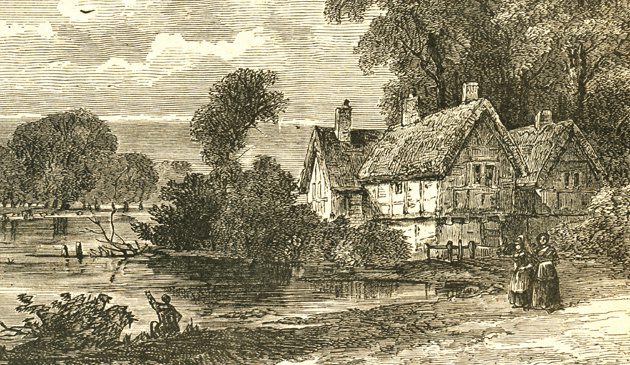London’s Restoration pleasure gardens

The water entrance to Cuper’s Gardens with its octagonal gazebo, across the Thames from the Savoy and Somerset House. From the entrance, known as Cuper’s Stairs, a short lane led to the pleasure gardens. The print dates from about 1730 and is taken from a painting by the maritime artist Samuel Scott.
From the 1640s, during the puritanical years of the Interregnum, various forms of enjoyment were prohibited. Following the Restoration of the monarchy in 1660 theatres reopened and flourished. At the same time, other forms of entertainment and relaxation came into existence, including pleasure gardens.
Prior to the 19th century London was still quite small, so it was relatively easy for people to escape from the squalid city to the countryside on foot or by carriage. Various spas outside the city provided entertainments, a garden, and food and drink. An alternative, for the upper classes, was the royal parks. The lands of Hyde Park and St. James’s Park to the west of London had opened in the early 17th century to ‘people of quality’ where they could promenade alongside royalty and aristocracy.
Over a century earlier, during the reign of Elizabeth I, a section in the north-east corner of St. James’s Park, close to where Admiralty Arch is now located, was laid out as the ‘Spring Garden’, named after the spring that was located there. By the early 17th century the Spring Garden contained a bathing pond, fountains, gravelled paths, and fruit trees, as well as “beasts and fowls”. John Evelyn mentions eating in the garden in a diary entry of 1653. The following year he describes the garden as a “Paradise” and mentions that “it is usual there to find some of the young company till midnight”. The garden has long gone but a street there still bears the name of Spring Gardens.
Seeing the potential for profiting from entertaining Londoners of all classes, several entrepreneurs began to create ‘pleasure gardens’. These were enclosed outside spaces a short distance from the city, an idealized substitute for the countryside. People could promenade there in a safe and pleasant environment, especially during evenings, with refreshments and various forms of entertainment. In the 200 years from the mid-17th to mid-19th centuries there were at least 60 pleasure gardens around London.
The first of London’s pleasure gardens that we know much about is the New Spring Gardens. It lay upstream of Westminster at Vauxhall, between where Goding Street and St. Oswald’s Place are located today, now close to the MI6 building and on the opposite bank of the river to Tate Britain. It opened in about 1661, when people could once again begin to entertain and be entertained.
The area of Vauxhall at Lambeth on the east bank of the Thames was then outside of the urban area of London and Westminster and until the 19th century still quite remote from London. To reach it by road in the 17th century required crossing London Bridge and then a journey of about 2½ miles south-west, through Southwark and St. George’s Fields, passing Lambeth Marsh. Most people took the more pleasant 30-minute journey by boat along the Thames, with many a willing waterman to take them there from any of the many landing stages in the City and Westminster.
The locality’s name derives from a mansion located there in the 13th century belonging to Falkes de Breauté, which name evolved as Falkes Hall or Foxhall. The area came to be held by Christ Church Canterbury and later occupied by multiple owners. On the Thames were various boatyards and landing stages, while away from the riverside the place was known for its market gardens.
Other attractions in the same area were the Lambeth Wells, known for their purging waters, and several inns such as the Three Coneys that provided music, and the Dog and Duck where ducks could be hunted on its pond. Close by, for the curious, was the garden and collection of curios from around the world of the Tradescants, father and son, which opened to the public in 1634 and several decades later became the basis of the Ashmolean Museum at Oxford.
In its first year John Evelyn noted: “I went to see the new Spring-Garden at Lambeth a pretty contriv’d plantation”. It seems there had been an older Spring Garden close by because in May 1662 Samuel Pepys recorded:
With my wife and the two maids and the boy took boat to Foxhall – where I have not been a great while – to the Old Spring garden. And there walked long and the wenches gathered pinks. Here we stayed; and seeing that we could not have anything to eat but very dear and with long stay, we went forth again… Thence to the New one, where I never was before, which much exceeds the other. And here we walked…
Pepys no longer describes the garden as ‘new’ after the second mention in his diaries, indicating that it was probably established in 1661.


